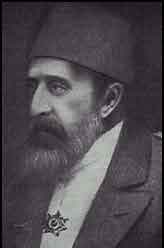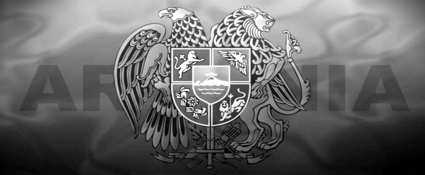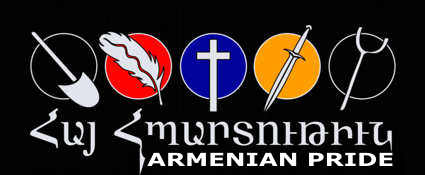Enver Pasha
Ismail Enver,
known to Europeans during his political career as
Enver Pasha (Istanbul, November 22, 1881 - August 4,
1922) was a military officer and a leader of the
Young Turk
revolution in the closing days of the Ottoman
Empire. He was a vocal supporter of eliminating the
non-Turkish population of the rump Ottoman Empire.
In April 1912
the Young Turks (officially the C.U.P.) won an
overwhelming majority in an election, but loss of
the province of Libya to Italy and other setbacks
eroded its support to the point that in July the
C.U.P. was forced to yield to a political coalition
called the Liberal Union, which formed a ministry.
In a coup on January 23, 1913, the C.U.P. overthrew
the Liberal Union coalition and introduced a
military dictatorship headed by the "Three Pashas" -
Cemal, Enver and Talât. Enver's portfolio was
Minister of War. With the opening of hostilities in
World War I the Ottomans suffered a disastrous
defeat almost immediately, when the Third Army was
decimated in eastern Anatolia in December 1914,
during an abortive offensive led by Enver against
Russia. On suspicions that Russian sympathisers
within the Armenian community were planning a
revolt, he ordered that Armenian recruits in the
Ottoman forces be disarmed, demobilized and assigned
to labor camps, where they were summarily executed.
Turkish sources claim, however, that the demobilized
Armenian soldiers were returned to Armenia.
Enver was not
directly in charge of the Armenian Genocide of 1915,
but according to Armenian resources, on May 19,
1916, Enver declared, "The Ottoman Empire should be
cleaned up of the Armenians and the Lebanese. We
have destroyed the former by the sword, we shall
destroy the latter through starvation." He further
stated, "I am entirely willing to accept the
responsibility myself for everything that has taken
place."
At the end of
the war Talât resigned days before the empire
capitulated and signs an armistice on October 30.
The C.U.P. Cabinet resigned en masse in the next two
days, and the "Three Pashas" fled into exile. A
post-war tribunal in Istanbul tried him in absentia
and condemned him to death.
Enver was ironically
killed in action against an Armenian batallion of
the Red Army on August 4, 1922, near Baldzhuan in
Turkestan (present-day Tajikistan).
Talat Pasha
Mehmed Talat Pasha
(Turkish: Mehmet Talat Paşa) (1872-1921) was one of leaders of
the Young Turks, Ottoman statesman, grand vizier (1917), and
leading member of the Sublime Porte from 1913 until 1918. One of
the architects of the Armenian Genocide.
Soghomon Tehlirian, whose family had been
killed in the Armenian genocide, assassinated the exiled Talat
in Berlin in March 1921 and was subsequently acquitted after a
jury trial.
Talaat was buried into the
Turkish Cemetery in Berlin. In 1943, his remains were taken to
Istanbul and reburied in Şişli. His war memories were published
after his death. A Black Book
kept by Talaat detailing numbers of Armenian deportees was
recently released by Talaat's relatives and has become a major
source of proof of the Armenian Genocide.
Quotes
In a conversation
with Dr. Mordtmann of the German Embassy in June 1915...
-
Turkey is taking
advantage of the war in order to thoroughly liquidate
(grundlich aufzaumen) its internal foes, i.e., the
indigenous Christians, without being thereby disturbed by
foreign intervention.
After the German
Ambassador persistently brought up the Armenian question in
1918, Talat said "with a smile"...
-
What on earth do you want? The question is settled. There
are no more Armenians.
-
TALAAT PASHA'S TELEGRAM
Now as for that tall story, according to which Catholics and
Protestants were not deported, it is true that there were a
number of telegrams sent regarding this subject in order
that the local responsible authorities could prevent such
deportations. But the first message sent was already dated 4
August 1915. That is, it was sent 3 months after the
deportations.
The first document about
Catholic Armenians was sent by Talaat Pasha. The telegram
stated that the deportation of Catholic Armenians should not
take place. A similar telegram was sent on 15 October about
Protestant Armenians. There, too, the following was said:
those Protestant Armenians who haven't been deported yet,
shall not be deported anymore. As inferred from both
telegrams, Armenian Catholic and Protestants had already
been deported prior to that date.
Now in telegrams sent on 18
September 1915 from Kayseri, Eskishehir, Diyarbakir, and
Nigde, governors replied that all the Armenians in their
respective regions had been deported and that none remained.
From many documents, we
understand that those telegrams of Talaat Pasha were sent
"merely for the sake of doing it". Later, verbal
instructions were sent to the same governors so that they
would not take those telegrams seriously. But even the
above-mentioned documents alone are sufficient to show that
the claim that Catholics and Protestants had not been
deported is a tall story.
Let's hope that, this painful page
of the history accepted in the international public opinion
as the Armenian Genocide and that among us it is recalled
only as the "Armenian Question", stop being for us a topic
on the agenda only in the month of April, and that it shall
be the object of a general serious discussion rid of
legends, because he who doesn't face his own past, cannot
build his future.
Cemal Pasha
Cemal (pronounced,
and often spelled Jemal) was similarly killed by
Stepan Dzaghikian, Bedros Der Boghosian and Ardashes
Kevorkian in Tbilisi, Georgia.
Quotes
To a German officer
upon seeing the deportations in Mamure said...
-
I am
ashamed of my nation (Ich schame mich fur meine
Nation)
Minister of
the Interior of Turkey publicly declared on March 15
that on the basis of computations undertaken by
Ministry Experts...
-
800,000 Armenian
deportees were actually killed...by holding the
guilty accountable the government is intent on
cleansing the bloody past.
 Massacres of Sultan Abdul Hamid
II
Massacres of Sultan Abdul Hamid
II
It was in such
conditions as you saw described in the previous
part, that in 1876 Sultan Abdul Hamid became king of
the empire by the help of Medhat Pasha, who was at
the head of the liberal groups. First the Sultan
killed the Medhat Pasha and then in 1878 dissolved
the national parliament and he himself was set at
the head of affairs. He was a very tricky despot and
meanwhile he was a blood-thirsty dictator.
The condition of
Armenians became more deplorable and frightening
than it had been since the beginning of the
domination of the Ottomans. There was no day that in
any Armenian city or village, some people were not
murdered. Kurds, who were tent-dweller tribes that
subsisted by robbing
villagers, occasionally came down from the mountains;
after murdering and plundering some Armenian
villages, they returned to the mountains.
The conditions were
such that Turks and Kurds around Armenian villages
were armed; each day the government armed them more,
but Armenians didn't have the right to keep weapons
in order to defend themselves against aggressive
Kurds and Turks. None of the Armenians, both man and
woman, old and young, in fields, in streets, in
houses or even in churches, had security of life.
There were no trials
or punishments if Turks or Kurds encroached on the
life, property and chastity of Armenians. When an
Armenian complained to the court that such and such
Turk or Muslim had raped his daughter, the first
reaction of the court was to arrest the Armenian
himself and send him to prison.
The courtiers
uniformed the plundering Kurds to establish them as
officials and made them gendarmes of Armenians, in
order to encourage the Kurds to kill, plunder and
encroach on Armenians.
These groups, which
were established by the order of Sultan Abdul Hamid,
were called "troops of Hamid" (Afvajeh Hamidiyeh)
and they were rare and incomparable in their cruelty
and crimes.
The obvious result of this measure was that the
Kurds were armed to the extreme, their felonies and
crimes were made legal, Armenian lands were taken
over and finally, the Armenian population in the
region was decreased. Attacking Hamidian troops or
defending oneself against them, was counted as
revolt and resistance against the government, and
was followed by heavy punishments for Armenians.
It was the year 1894.
Mass murders had not started yet, but some scattered
and successive massacres of Armenians, made life
frightening and every day was passed in fear of
armed robbery, rape, and slaughters. The European
governments notified the Sultan several times, but
they were in reality just paying lip service; the
Sultan deceitfully promised reforms every time.
Reforms had been promised for 40 years but they
never came.
At last in 1894, the
limited and scattered massacres turned into mass
murders that spread all over the empire. Suddenly
the number of murdered reached a rare level, and the
massacring of Armenians generalized and spread
contagiously from place to place. First the matter
started because the Armenians of the mountainous
region of Sasoun, located in Bitlis province, stood
up against criminal encroachments of Kurds.
At the same time, the
Turkish army joined in the attacks on Armenians,
first burning some Armenian villages and then
murdering thousands, cooperating with Kurds. The
European powers with, England at the head,
intervened in order to stop the massacres and the
Sultan promised some reforms to European governments
by the particular trickery which he had. But the
slaughters not only weren't stopped but also gained
more intensity and speed.
In the slaughters of
Armenians during the years 1894-1896, which
harvested the Armenian inhabitants one after
another, in Western Armenia and Anatolia (eastern
parts of Turkey), Trabzon, Erzinchan, Bitlis, Van,
Marash, Urfa, Bayburt, Sasoun, Mush, Diyarbakir,
Erzrum, Cilicia (Adana), Angora (Ankara) ... , over
300,000 Armenians were butchered disastrously.
For an example of
their crimes, take the 28th of December 1895 in
Urfa. Over 2500 Armenian men, women and children,
fearing for their lives, had sought refuge in the
altar of a church; undeterred Ottoman gendarmes set
the church afire and its inhabitants were burnt
alive.
On the 26th of August
1896, some of the Armenian youth, in order to draw
the attention of the public figures of Europe to the
events which were happening in the empire, took over
the central bank in Constantinople (Istanbul), the
capital of Ottoman, and asked that the Armenian
massacres be stopped and that the promised reforms
be carried out. But three days after the end of the
venture, the violence of Ottoman Turks exploded and
tens of thousands of Armenians were butchered and
cut to pieces in the streets of Constantinople.
These were vengeances which had been designed
beforehand and led by Sultan Abdul Hamid himself.
After these
massacres, no other mass murders occurred until
1908; in this year suddenly mass murder and
plundering of Armenians was committed, this time in
Constantinople, in front of the very eyes of foreign
delegations, diplomats and big powers of Europe.
This massacre gained a strong reaction in Europe and
injured the credit and respectability of the Sultan
seriously; he was given titles such as, The Red
Sultan, The Red Animal, The Monster of ildiz,... .
All the polticians and intellectuals of Europe, both
left and right, liberal and conservative, condemned
the massacres of Armenians in Turkey severely.
At last, in the same
year, 1908, Sultan Abdul Hamid was faced with a coup
d'etat by Turkish revolutionists, who were called
Young Turks. the result was that his sultanate took
on a ceremonial aspect and the next year, 1909, he
was deposed by the Young Turks completely.
Mustafa Kemal Atatürk
Mustafa
Kemal Atatürk (1881 in
Salonica (present-day
Greece) – 10 November 1938 in
Istanbul (present-day Turkey) was the founder of the
modern Turkish Republic in 1923. He is revered
throughout Turkey and in an interview published on
August 1, 1926 in The Los Angeles Examiner, spoke
unfavorably of the former Ottoman Young Turk
government that orchestrated the Armenian Genocide:
These left-overs from the former
Young Turk Party, who should have been made to
account for the millions of our Christian
subjects who were ruthlessly driven en masse,
from their homes and massacred, have been
restive under the Republican rule.
TOP

